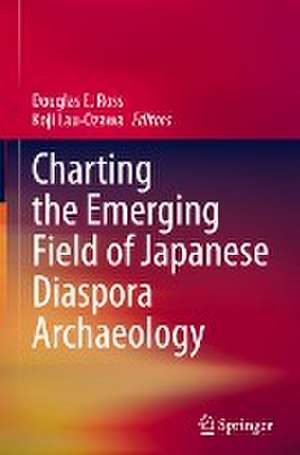Charting the Emerging Field of Japanese Diaspora Archaeology
Editat de Douglas E. Ross, Koji Lau-Ozawaen Limba Engleză Hardback – 30 apr 2023
Previously published in International Journal of Historical Archaeology Volume 25, issue 3, September 2021
| Toate formatele și edițiile | Preț | Express |
|---|---|---|
| Paperback (1) | 687.26 lei 38-45 zile | |
| Springer Nature Singapore – mai 2024 | 687.26 lei 38-45 zile | |
| Hardback (1) | 789.52 lei 6-8 săpt. | |
| Springer Nature Singapore – 30 apr 2023 | 789.52 lei 6-8 săpt. |
Preț: 789.52 lei
Preț vechi: 962.83 lei
-18% Nou
Puncte Express: 1184
Preț estimativ în valută:
151.07€ • 157.73$ • 125.03£
151.07€ • 157.73$ • 125.03£
Carte tipărită la comandă
Livrare economică 04-18 aprilie
Preluare comenzi: 021 569.72.76
Specificații
ISBN-13: 9789819911288
ISBN-10: 9819911281
Pagini: 336
Ilustrații: VI, 336 p. 1 illus.
Dimensiuni: 155 x 235 mm
Greutate: 0.66 kg
Ediția:2022
Editura: Springer Nature Singapore
Colecția Springer
Locul publicării:Singapore, Singapore
ISBN-10: 9819911281
Pagini: 336
Ilustrații: VI, 336 p. 1 illus.
Dimensiuni: 155 x 235 mm
Greutate: 0.66 kg
Ediția:2022
Editura: Springer Nature Singapore
Colecția Springer
Locul publicării:Singapore, Singapore
Cuprins
Critical Mass: Charting a Course for Japanese Diaspora Archaeology.- A History of Japanese Diaspora Archaeology.- Archaeological Examination of Japanese Photographs and Archival Data from the Pre-WWII Okinawan Diaspora: Tinian, Commonwealth of the Northern Mariana Islands.- Jizo (Ksitigarbha) Statues under Palm Trees: The Materialization of Early Japanese Immigrant Culture in Hawai‘i.- Introduction of Lifecycle of Community Framework: Grappling with Multiple, Complex Datasets in Interpreting Yama/Nagaya, a Late Nineteenth- to Early Twentieth-Century Pacific Northwest Japanese Immigrant Village.- The Materiality of Anti-Japanese Racism: “Foreignness” and Racialization at Barneston, Washington (1898-1924).- Japanese Ceramics and the Complexities of Consumption in “this Knife-Fork Land”.- Archaeology of Early Twentieth-Century Japanese Canadian Logging Camps in British Columbia.- The Japanese American Experience in San Luis Obispo during the Interwar Years.- Towards an Archaeology of the Japanese Diaspora in Peru.- Towards an Archaeology of the Japanese Diaspora in Peru.- Diaspora and Social Networks in a World War II Japanese American Incarceration Center.- Inscriptions and Silences: Challenges of Bearing Witness at the Gila River Incarceration Camp.- The Future of Japanese Diaspora Archaeology in the United States.- Speaking beyond the Discipline: Japanese Diaspora Archaeology in Dialogue.
Notă biografică
Dr. Douglas Ross earned a PhD in Archaeology from Simon Fraser University in 2009, is a Registered Professional Archaeologist, and has been a Project Manager at Albion since 2016. He is responsible for the management and direction of projects that impact postcolonial resources. Doug develops management plans and directs survey, testing, and data recovery projects. Over the past two decades, he has worked internationally on a range of sites spanning the 16th through 20th centuries. His primary area of expertise are archaeological resources from the western US and Canada dating to the late 19th and early 20th centuries, particularly sites associated with Chinese and Japanese immigrants. He is a leading expert on Japanese ceramics recovered from historic sites and the history and practice of Chinese diaspora archaeology in North America.
Koji Lau-Ozawa is an historical archaeologist whose research examines the intersecting realms of landscapes, diaspora,material culture, and memory. His research focuses on the archaeology of the Japanese diaspora, examining the material connections and landscapes of Japanese American communities. In particular he has worked in collaboration with the Gila River Indian Community to investigate the site of the WWII Gila River Incarceration Camp. This long-term project combines archaeological, oral historical and archival research in a transnational framework to study the camp landscape and flows of material culture. He has also conducted investigations on the material culture of a pre-WWII urban Japanese American community in Santa Barbara. These projects have been supported by the Wenner-Gren Foundation, The Japanese American Confinement Sites Grant, as well as the Society for California Archaeology.
Textul de pe ultima copertă
This book examines the Japanese diaspora from the historical archaeology perspective—drawing from archaeological data, archival research, and often oral history—and explores current trends in archaeological scholarship while also looking at new methodological and theoretical directions. The chapters include research on pre-War rural labor camps or villages in the US, as well as research on western Canada (British Columbia), Peru, and the Pacific Islands (Hawai‘i and Tinian), incorporating work on understudied urban and cemetery sites. One of the main themes explored in the book is patterns of cultural persistence and change, whether couched in terms of maintenance of tradition, “Americanization,” or the formation of dual identities. Other themes emerging from these chapters include consumption, agency, stylistic analysis, community lifecycles, social networks, diaspora and transnationalism, gender, and sexuality. Also included are discussions of trauma, racialization, displacement, labor, heritage, and community engagement. Some are presented as fully formed interpretive frameworks with substantial supporting data, while others are works in progress or tentative attempts to push the boundaries of our field into innovative new territory. This book is of interest to students and researchers in historical archaeology, anthropology, sociology of migration, diaspora studies and historiography.
Previously published as a Special Issue in the journal: International Journal of Historical Archaeology "Special Issue: Charting the Emerging Field of Japanese Diaspora Archaeology"
Caracteristici
Examines the Japanese diaspora from the historical archaeology perspective Draws its analysis from archaeological data, archival research, and often oral history Explores current trends in archaeological scholarship while also examining new methodological and theoretical directions
